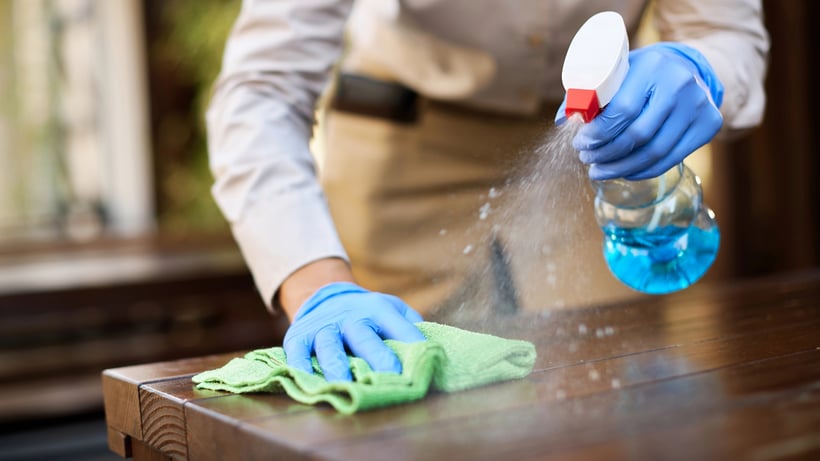
Chemical contamination occurs when food is contaminated by chemicals. Some of the most common causes of chemical contamination are cleaning products or pesticides and herbicides from unwashed fruit and vegetables.
Examples of chemical contaminants are:
- industrial chemicals
- agricultural chemicals
- toxic metals
- preservatives
- naturally occurring toxins
Industrial chemicals
Industrial chemicals and cleaning products include detergents, sanitizers and other chemical products that you may have on-site.
Always store these well away from food and food preparation areas, and store in their original labelled containers.
Never store chemicals in containers that were used for food, and don’t store food in containers that were used for chemicals. And always remember to rinse items when cleaning and sanitizing.
Agricultural chemicals
Agricultural chemicals include herbicides, pesticides and fertilizers that may be present on fruit and vegetables.
Always wash fruit and vegetables – even if the item has a thick skin or rind, you are still in danger of transferring chemicals from the outside to the inside when you cut into the product.
Choose fresh produce suppliers for your business that have programs in place to prevent contamination.
Toxic metals
Toxic metal contamination can occur when using pots and pans, food containers or utensils that have been manufactured using non-food grade materials, or that are not suitable for the purpose for which they are being used.
Storing acidic food in galvanized metal containers can cause chemical contamination. Use food-grade plastic containers instead.
Preservatives
Preservatives are ingredients added to food to make it last longer or taste better. Example preservatives include sulphites in wine and nitrates used in meat.
Adding too much preservative to a food can be harmful to human health. Always use reputable suppliers and follow instructions when using these products.
Naturally occurring toxins
Naturally occurring chemical toxins are chemicals that are produced or contained naturally within shellfish, seafood or plants.
These toxins may not cause any harm to the organism that produces them but can be harmful to humans. Paralytic Shellfish Poisoning is an example of an illness caused by consuming a naturally occurring toxin.
Always purchase seafood and fresh produce from reputable suppliers to avoid this type of toxin.
How chemical contamination happens
There are many ways that food can become contaminated by chemicals in a food business. Food Handlers can accidentally cause chemical contamination if they:
- don't handle, store and label cleaning chemicals properly
- use too much detergent or sanitizer to clean food preparation surfaces, glassware, dishes or cutlery
- don't rinse surfaces, glassware, dishes or cutlery properly after cleaning and sanitizing
- don't wash fruits and vegetables properly to remove pesticides
- don't use kitchen equipment or storage containers made of food-grade plastic or metals
- use pest control products (e.g. roach spray) in areas where food is prepared
How to prevent chemical contamination
To prevent chemical contamination from happening in your business:
- always label and store chemicals separately from food
- use the appropriate chemical for the job you're doing
- always follow the chemical manufacturer's instructions with regards to dilution, contact time and water temperature
- use chemical pest control products with care or outsource pest control activities to a professional pest control service
- ensure everyone in your business has completed the relevant training (Food Handler Certification Course, WHMIS Course)
Find out more about contamination
There are three types of contamination: chemical, biological and physical. Any of these types of contamination can occur in a food business, and rigorous controls are required to prevent it from happening. Find out more about the different types of contamination and how to prevent cross-contamination.
Control methods and procedures should be laid out in detail in your Food Safety Plan. Food Safety Plans are important for any food business and help to protect consumers from food safety risks, including food poisoning or allergic reactions. In most provinces and territories, Food Safety Plans are required by law and should be based on the seven principles of HACCP.
Find out more about Food Safety Plans and the seven principles of HACCP by downloading the CIFS Guide to Understanding HACCP Principles.
Need to create a Food Safety Plan for your business? The CIFS HACCP Food Safety Plan Kit can help. It comes complete with all the information, tools and instructions you'll need to build a compliant Food Safety Plan tailored to your business.





